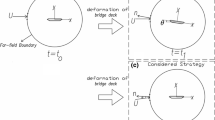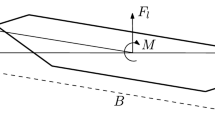Abstract
This paper outlines the essentials and procedures of computational fluid dynamics (CFD) simulation applicable to evaluating flutter derivatives of bridge decks. An arbitrary Lagrangian-Eulerian (ALE) description of the flow around the moving rigid box girder combined with the finite volume discretization and multi-grid algorithm is presented. The proposed methods are employed to identify flutter derivatives of the bridge deck of the Sanchaji Selfanchored Suspension Bridge. The results agree well with ones from wind tunnel tests. It demonstrates accuracy and efficiency of the present method.
Similar content being viewed by others
References
Walther J H, Larsen A. 2D discrete vortex method for application to bluff body aerodynamics. Journal of Wind Engineering and Industrial Aerodynamics, 1997, 67/68: 183–193
Larsen A, Walther J H. Aeroelastic analysis of bridge girder sections based on discrete vortex simulations. Journal of Wind Engineering and Industrial Aerodynamics, 1997, 67/68: 253–265
Frandsen J B. Computational fluid-structure interaction applied to long-span bridge design. Dissertation for the Doctoral Degree. Cambridge: University of Cambridge, 1999
Shirai S, Ueda T. Aerodynamic simulation by CFD on flat box girder of super-long-span suspension bridge. Journal of Wind Engineering and Industrial Aerodynamics, 2003, 91: 279–290
Jeonga U Y, Kwon S D. Sequential numerical procedures for predicting flutter velocity of bridge sections. Journal of Wind Engineering and Industrial Aerodynamics, 2003, 91: 291–305
Zhu Zhiwen, Chen Zhengqing, Gu Ming. Evaluating flutter derivatives of the thin plate by using the numerical simulation method. Journal of Hunan University (Natural Sciences), 2005, 32(5): 11–15 (in Chinese)
Scanlan R H, Tomko J J. Airfoil and bridge deck flutter derivatives. J Eng Mech Div ASCE, 1971, 97(6): 1717–1737
Chorin A J. Numerical solution of the Navier-Stokes equations. Math Comp, 1968, 22: 745–762
Zhu Zhiwen, Chen Zhengqing, Gu Ming. Identification of flutter derivatives by using eigensystem realization algorithm. Journal of Shock and Vibration, 2006, 25(5): 28–31 (in Chinese)
Author information
Authors and Affiliations
Corresponding author
Additional information
__________
Translated from Journal of Hunan University (Natural Sciences), 2007, 34(3): 6–10
Rights and permissions
About this article
Cite this article
Zhu, Z., Wang, Z. & Chen, Z. Computational fluid dynamic analysis of flutter characteristics for self-anchored suspension bridges. Front. Archit. Civ. Eng. China 2, 267–273 (2008). https://doi.org/10.1007/s11709-008-0034-6
Published:
Issue Date:
DOI: https://doi.org/10.1007/s11709-008-0034-6




